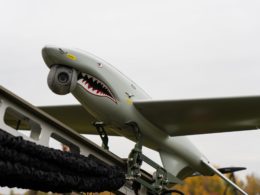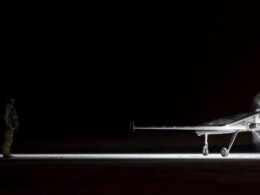According to spokesman of Ukraine's Air Force Yurii Ihnat, Iranian Shahed-136 kamikaze drones can cover a distance of up to 1,000 kilometers amd the Russian occupiers can use them to attack Ukraine from different directions, Ukrainska Pravda reported.
The Air Force spokesman said that Shahed-136 are difficult to shoot down:
"The target is complex, it is not so large: the wingspan is 2.5 meters, the weight is 200 kilograms, the warhead is 40 kg. In fact, it is like an artillery shell that flies at a speed of 120 kilometers per hour, and when it enters the target, it descends at a higher speed."
He noted that despite Shahed 136's advertised range of 2500 km, it is closer to 1000 km in real world conditions.
Around 12 Iranian drones attacked Ukrainian territory from the south of the country on 5 October. Six of them were shot down, three by anti-aircraft missile forces in the south, and three by Ukraine's Air Force.
The rest reached Kyiv Oblast, where they struck Bila Tserkva.
Ihnat noted that despite this strike being carried out from the south, where Russia occupies Ukrainian territory, Ukraine should expect Iranian drone attacks from other directions, because Russia could have stationed them in occupied Crimea and Belarus.
Ihnat noted that the Iranian drones are a new threat to Ukraine's defense forces and it is necessary to destroy them by all available means.
For this purpose, the Ukrainian army needs various means of air defense, including anti-aircraft guns and large-caliber machine gun systems that can destroy at different stages.
The spokesman confirmed that Russia has switched from using high-precision missiles, which cost millions of dollars X-101, Kalibr, X-555, Iskander, to attacking Ukraine with drones.
Probably, Russians are going to save these missiles, which are capable of carrying tactical nuclear warheads, to threaten the whole world, he said.
Iranian Shahed-136 drones in the war against Ukraine
On September 16, the Air Force of the Armed Forces of Ukraine confirmed that the Russian military uses Iranian drones in Ukraine for the first time. They noted that shooting down this target is extremely difficult, so additional equipment and intense monitoring by the air defense units are required.
Yurii Ihnat, the spokesperson for the Air Force Command explained that Shahed 136 is barely visible on radars; it’s a relatively small aerial target that flies mainly at a low altitude. It can be shot down with different air defense systems, or even small arms. But the best options, in this case, would be anti-aircraft guns or, for example, such air defense systems as Ukraine’s ZSU-23-4 Shylka or Germany’s Gepard. Also, the drones can be taken down with electronic warfare systems.
Trending Now
The Ukrainian military has been shooting down Shahed-136s on the battleground. For example, on September 22, 5 kamikaze drones were shot down over Mykolaiv Oblast. At least four of them were Iranian-made Shahed-136s. The drones were used against Ukraine during its recent successful offensive in Kharkiv Oblast, creating problems for Ukrainian artillery units, WSJ reported.
The Washington Post and CNN reported earlier that Iran had sent a batch of unmanned aerial vehicles to Russia. According to them, drones Mohajer-6, Shahed-129, and Shahed-191 were sent to Russia on August 19. Sources close to US intelligence said that the Russian military was dissatisfied with the first tests of the Iranian UAVs, as they faced numerous malfunctions. However, according to WP, Moscow intends to buy hundreds of such drones from Tehran.
Although Iran’s drone program has been developing since the late 1980s, the country is under sanctions, and many of the drones are believed to have been largely copied from foreign vehicles.
A report shared earlier revealed that the Iranian Shahed-131 drone which is similar to the Shahed-136, has US-produced CPUs.
Most of Russia’s attacks by Iranian drones on Ukrainian cities were carried out on the southern cities of Odesa and Mykolaiv.
The first Iranian Shahed-136 drone attack on Odesa happened on 23 September. Then, a civilian was killed. On 5 October, the drones attacked Bila Tserkva, a city in Ukraine's north.
Iran denies sending drones to Russia.





